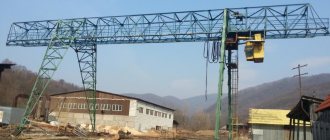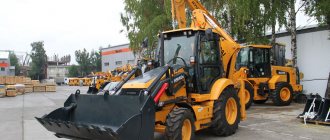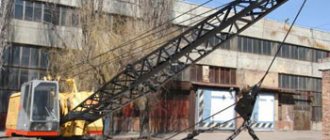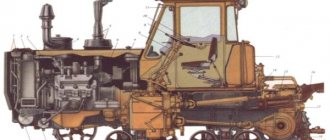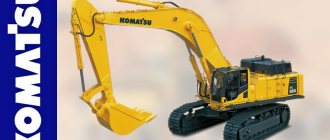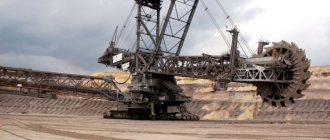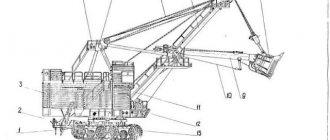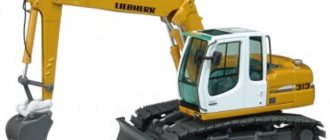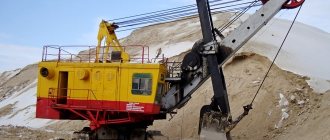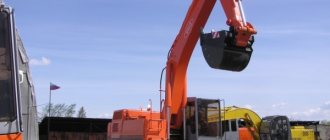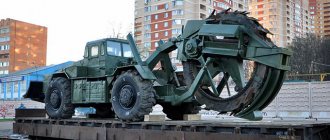Walking excavator - what is it? How does it work. How does the ShE differ from other excavators?
If you have ever been able to see how natural resources are mined, then you will, without a doubt, forever remember the mining excavator, which stands out from other similar equipment with its dimensions and ability to “walk”!
For the last feature they gave it a name - “I walk.” The responsibilities of the ESh include the development and transfer of soils during overburden operations in coal and mining quarries, and it is also used for excavation work in the construction of large hydraulic structures. This movement mechanism, which gave the name to these excavators, was not chosen by chance; the fact is that the mass of powerful and large excavators weighing from 180 to 10,000 tons and, when used as any other move, would exert ultra-high pressure on the ground, which did not contribute in any way would be sustainability. The walking device, as such, is connected to work only when the excavator is moving. But the rest of the time, the “body” of the excavator rests on a round base, which has a large supporting area, and thanks to this movement, the pressure on the ground becomes several times less than that of conventional crawler mining excavators. In a nutshell, this “device” works like this - the excavator, when stationary, rests on the ground with a base plate at its base, and when it is necessary to “step”, then when stepping, the weight is redirected to the “skis” or shoes. And each shoe is controlled by hydraulic cylinders - two pairs for each. The excavator, when performing a step, rises above the surface where it stands, moves a certain distance, and again lowers on the base plate to the ground. In turn, the support shoes are raised above the ground, moved forward, and then the cycle is repeated if necessary. But more on that later. The rotary platforms have a low location, which is simply necessary in order to simplify the travel mechanism and increase the stability of the excavator. This explains the practical use of only one working equipment - a dragline (in addition, it is also possible to use grab equipment). And because of this, it would be more correct to call these giants, not walking excavators, but walking draglines. Now, as a rule, they are equipped with a dragline mechanism.
So, the difference between dragline excavators and conventional excavators is that the former, instead of rigidly attaching the bucket to the handle, use a flexible chain attachment of the bucket to the ropes. And there the calculation is made so that the machine will scoop and not dig.
In quarry conditions, conventional excavators for tracked operation have a strict weight limit of 800 tons. And if this value is exceeded, it is quite difficult, or rather almost impossible, to achieve the permissible value of pressure on the soil, which is equal to 2 kg per cm2. Here lies one of the important advantages of excavators that have a walking mechanism at their disposal - they do not have this problem.
In the USSR, and later in the Russian Federation, the designation for walking excavators was adopted - ESH. It was decided to use draglines weighing from 500 tons and with a boom of 60 meters for loading rock mass into quarry transport at the very beginning of the design and production of ES. For example, if it is necessary to develop watered horizons, where an unstable foundation limits the possibility of installing classic mechanical shovels and laying a road for special vehicles is impractical.
However, as it turned out later, classic walking excavators are effectively unable to cope with such work.
Review of "ESH 20.90"
The drive in this case is used from the “TG” series. The bucket is installed with a capacity of exactly 10 cubic meters. meters. The boom of the ESH 20.90 excavator has a total length of 75 meters. It can withstand a maximum end load of about 36 tf. The unloading height of this model is 30 meters. The specific pressure during operation of the device on the ground is 0.09 MPa. The shoe in this case is installed exactly 10 meters long.
The traction mechanism can boast a maximum power of 450 kW. In turn, the propulsion system has only 300 kW. The working weight of the presented excavator when assembled reaches 1200 tons. The clearance under the rear platform is quite large. The digging radius in this case is approximately 71 meters. Thus, the “ESH 20.90” configuration is most suitable for quarry work.
Learn more about how a walking excavator walks?
The ESh “walking” device consists of two skis, which are connected by means of a hydraulic cylinder or an eccentric mechanism, and a round frame at the bottom. A rotating platform is installed on the frame through a rotating support mechanism.
The “giant” carries out its walking in the following way. In order for the ES to take the first “step,” the skis are advanced in the required direction using hydraulic cylinders and then lowered to the ground. Further, using the same hydraulic cylinders, the machine body rises up to the maximum. At this point, the hydraulic cylinders are installed vertically, and the end of the support frame is pulled along the ground from the boom side. The excavator body, after selecting a direction to move, then slowly returns to the support frame. Car. Thus, having completed a “step”, he must either make a subsequent movement or return to work. When operating the ES, its skis are in a raised position and do not create unnecessary interference for the turntable and, in general, for other equipment around.
At first glance, it may seem that this unit is moving slowly, no faster than a snail. But this is far from true - an ES can “crawl” up to 200 m in an hour. When a walking excavator is operating, its walking stroke has a specific pressure that lies in the range of 0.4-1 kgf/cm2. But this is static - and during its movement these numbers increase 1.5-2.5 times - 1-1.5 kgf/cm2.
ESH draglines come off the assembly line with booms 40, 60, 75, 90, 100 meters in height and buckets with a capacity of 4, 6, 10, 14, 15, 25, 50 m3. Some brands produce equipment with booms up to 120 meters in height and buckets for large volumes of stripping work, which hold from 40 to 100 m3.
The classic ES is equipped with a boom, a bucket harness, and lifting and traction cable devices. A lifting rope is used to lift the bucket from the face and lift it above the ground. Unloading occurs at the maximum working radius. The mass from the bucket falls to the ground in bulk.
In the Russian Federation, as well as during the USSR, there was a designation system for walking excavators indicating the volume of the bucket - in m3, and the boom reach in meters. For example, a walking excavator model ESH-15/90, with a bucket capacity of 15 m3, the boom has a length of 90 m.
Device "ECG 5A"
This mining walking excavator is designed for unloading soil. The boom on it is installed with a total length of 60 meters. At the same time, buckets for it are suitable for different capacities. The most common is the model with a capacity of 10 cubic meters. meters. The operator can adjust the angle of the boom. In this case, it rotates 360 degrees. The walking running equipment of the EKG 5A excavators consists of a set of rotation mechanisms, as well as a drive. The model’s platforms are capable of withstanding a maximum weight of 600 tons. The theoretical performance parameter of the device is at the level of 620 cubic meters. meters per hour. The lifting force of the boom depends on the set degree.
The depth of the EKG 5A excavator is exactly 35 meters. In this case, the unloading radius is 66 meters. The clearance above the rotating base is quite large. Separately, it should also be noted the significant travel width at 13 meters. The body of the presented excavator is 10 m long. For light soils, the EKG 5A modification is excellent.
The largest walking excavator "Big Mask". Photo
The heaviest walking excavator in the world is considered to be a monster created in the 60s. This is a Bucyrus Big Musk 4250-W ESH that was used at a coal mine in Ohio. He worked diligently for nearly thirty years, and during his entire working life he moved a volume of rock mass that, for example, was at least twice as large as the volume of earthworks during the construction of the Panama Canal.
The excavator had the following gigantic dimensions: it had a “height” of 67.8 m, a width of 46.2 m, and a length of 148.6 m. In simple terms, it had the dimensions of a 22-story building. The volume of its body inside was 46x49x40 m. This monster weighed 13,500 tons! The boom had a length of 95 m, and a huge bucket was suspended from its end using steel cables with a diameter of 127 meters and weighing 230 tons! This huge “mouth” of the machine could scoop up to 168 m3 of rock. This titan moved on twenty-meter “skis”.
Characteristics of "ECG 10"
This excavator is usually used for trenching. At the same time, it is also suitable for quarry work. The performance of this model is at the level of 540 cubic meters. meters per hour. A walking excavator bucket is used in this case with a capacity of 8 cubic meters. The driver of the EKG 10 has the ability to raise the boom by a maximum of 30 degrees. In this case, the maximum lifting force is located at around 400 kN. The unloading height of this model is 27 meters. The clearance above the turntable in this case is quite large. The maximum stroke width of the EKG 10 excavator is 14 m.
Rotary special equipment
Rotary shagars work continuously, covering less land. The operating mechanism of a rotary excavator is based on the extension of a boom equipped with several buckets. The boom is also raised by means of cables launched by an electric winch.
The bucket wheel excavator is used to develop trenches with soil unloading.
The operation of bucket wheel excavators is represented in the following areas:
- excavation of rocks with upper and lower buckets;
- moving earth from faces;
- moving goods into transport;
- creation of channels and trenches;
- selective mining of rock layers.
Rotary shagars differ from their dragline counterparts in their higher productivity, which is guaranteed by a continuous operating mechanism. However, both models are used equally in the quarrying process.
R&N 4100 HRS
The time has come to introduce the most powerful excavator in Russia, the bucket volume of which is 57 m³. It was produced in the USA, and is used in coal mining in the Kuzbass coal basin.
It was with its commissioning that it was possible to significantly increase production volumes, and today the excavator helps to extract up to 15 million tons of coal annually.
Everything in the machine is done for the convenience of the operators servicing it. The machinery is operated by two people, and the cabins have toilets and a place to rest.
As we can see, large excavators are mainly used in quarries for mining, and their subsequent loading for transportation.
Technical progress does not stand still, and new challenges in the mining industry in the future may encourage designers of the world's leading companies to create larger mechanisms, and, of course, real masterpieces of mining technology will appear.
Marion 6360 "Captain"
Let us introduce, among the largest crawler excavators, a rare specimen that remains only in memory and in photographs.
After the accident, when there was a malfunction in the mechanism that caused a fire, it was decided to remove the car from service and dispose of it.
It was built in 1965 and was designed to perform a variety of jobs. The height of the arrows was 67 meters, and Marion weighed more than 13 thousand tons.
Bagger 288
The excavator can work non-stop thanks to the buckets located around the entire wheel. It was created by order of a company that extracts valuable rocks from the depths of the earth. The weight of the equipment is 13,500 tons, and a group of 4 people is required to service it. Bagger 288 is also recognized as one of the most beautiful excavators.
Large and scary-looking equipment helps extract valuable rocks. The creation and development of such a machine can take more than one year.
Features of the device "ESH 15.100"
This excavator can most often be found on construction sites where trenches are laid. The power of its traction mechanism reaches as much as 450 kW. However, the propulsion system has only 200 kW. Separately, it is worth mentioning a fairly strong tubular boom, which can withstand an end load of approximately 35 tf. The capacity of the bucket in this case is 11 cubic meters. meters. The clearance under the rear is no more than 1.3 meters long. The working cycle duration of the ESH 15.100 excavator does not exceed 60 s. The digging depth is 30 meters. During operation, the maximum pressure on the ground is 0.005 MPa.
